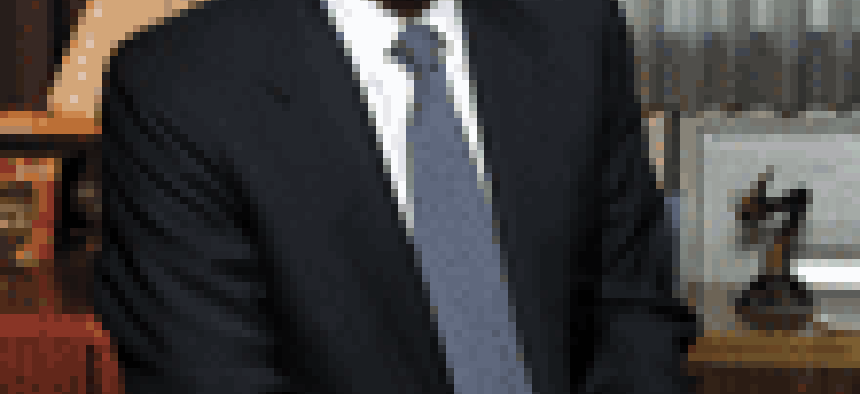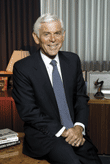Unisys Corp. was in a near shambles when Lawrence A. Weinbach took over in 1997.Saddled with $2.3 billion in debt, declining sales of its flagship mainframe line, increasingly disaffected customers and a future that bode ill for its main source of income'hardware'Unisys seemed to have little to recommend it.'In doing my homework on the company, what I found most interesting,' Weinbach said, 'was that here was a company close to bankruptcy, and its customers were still buying its products. It had to be doing something right.'The timing also was right. After eight years as CEO of Andersen Worldwide, steering that company from a $2.3 billion entity to an $11 billion professional services powerhouse, Weinbach had told his partners that it was time for a change.He came to Unisys headquarters in Blue Bell, Pa., as its new chairman, president and CEO, and met his first challenge: how to persuade 30,000 Unisys employees worldwide that they should change Unisys from a hardware and software maker to a services-led company, a vision that had already foundered under the previous CEO.'But vision is not about thought, it's about relentless execution,' said Greg Baroni, president of Unisys Global Public Sector. 'And Larry is all about the execution.''I told employees that there were only three things that were important: Our customers, our employees and our reputation,' Weinbach said.In his first three months on the job, he took his message to more than 20,000 employees around the globe and personally answered 4,000 e-mails from employees. 'It didn't change my strategy,' he said, 'but what it did was tell me where to look for problems.'During the same three months, he also met with more than 100 Unisys customers. He set up single points of contact for the 200 largest customers, and made each of the top 100 Unisys executives responsible for two of them.Wall Street pundits urged him to 'start with a clean sheet of paper,' he said. 'Others told me to change the name,' an idea that drew his derision. 'We're in more than 100 countries. It would have cost us $100 million just to change all the signage.'Instead, he steadfastly executed each step of his planned strategy, which excluded broad-based services such as data center management, which he referred to as 'your mess for less.'The company focused on high-margin services for vertical industries, such as processing bank checks or developing air cargo systems. 'We were developing a skill set an inch wide and a mile deep,' Weinbach said.By late 1999, he had negotiated strategic partnerships with Microsoft Corp., Motorola Inc., Nortel Networks Ltd., Oracle Corp., PeopleSoft Inc. and Siebel Systems Inc., each knitting Unisys more tightly to his target industries: not coincidentally, major users of Unisys hardware.The high reliability of the ClearPath mainframes that had defined Unisys since its creation by a merger between Sperry Rand Corp. and Burroughs Corp. in 1986, made them a common choice for telecoms and financial institutions.The company's newer ES7000 server line, based on Intel Corp. processors and running Microsoft software, competes against high-end Unix machines to power the big databases and ERP systems that help run many government agencies and private sector enterprises.By 2000, a year ahead of schedule, he had slashed the corporate debt by $1.2 billion, a feat he attributes to fiscal asceticism and programs such as SpendSmart, in which employees took fiduciary responsibility for day-to-day expenses. 'We never sold any assets to pay off debt,' Weinbach said proudly.But by 2001, despite a turnaround for much of its business, Unisys's government division was headed for the auction block.Unisys continued to win contracts. 'But a lot of that was as a reseller: buying PCs and putting them in,' Weinbach said.'We were going after all these [indefinite-delivery, indefinite-quantity] contracts,' he said. 'It looked like the revenue was strong, but when you got into it, we weren't developing the value-added capability that we needed. So we started hiring people who had the value-add skills.'In 2001, he met with Baroni, who had spent his 19-year career with KPMG Peat Marwick (now BearingPoint Inc.) building its federal business.'We're doing the wrong things,' Weinbach told him, then made him an offer: 'You want to have some fun with me building a value-added government business?'Baroni jumped at the chance to work with the man he calls 'a legend in this business, the epitome of impeccable integrity.'But also, he said, 'I felt that a solid federal business should be the foundation of an integrated strategy for Unisys. And I felt I could build it.'The turning point for the new government business, Weinbach said, 'was the Transportation Security Administration contract we got a little over a year ago. This was putting in a whole architecture.'Today, Unisys focuses on only five markets: government, financial services, telecom, transportation and nonmanufacturing commercial services, such as insurance.Services account for more than 75 percent of revenues, which are this year nearly $6 billion and are expected to top that figure in 2004.
'We were developing a skill set an inch wide and a mile deep.'
'Larry Weinbach
Melvin Epps, Special to GCN







